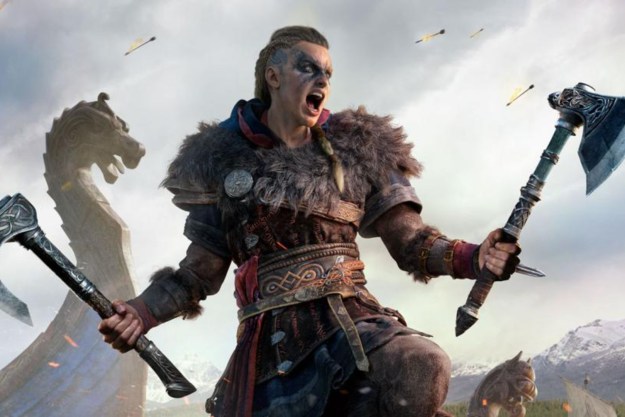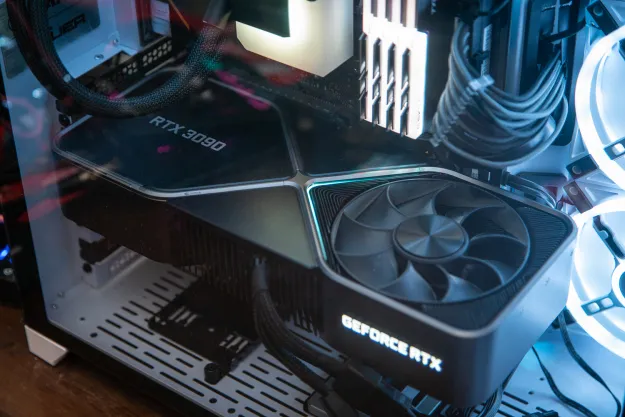Cloud gaming services are having a bit of a moment. PlayStation and Nvidia are already in the ring, while Google Stadia and Microsoft xCloud are gearing up to join the competition. Another option from a lesser-known French company, called Blade, is already available, too. Dubbed Shadow, Blade’s service is more of a complete cloud computing service centered on game streaming. If you’re interested in game streaming, you should get to know all of your options. Here’s everything you need to know about Shadow.
What is Shadow?

Shadow is a cloud gaming service that gives you virtual access to a beefy PC rig. To put it simply, Shadow broadcasts a virtual machine on your devices. You’re simply controlling a high-end PC without actually owning one. How high-end? When using Shadow, you have access to a Windows 10 PC with the following specs: Eight-thread Intel Xeon CPU, Nvidia Quadro P5000 GPU/GTX 1080 graphics cards, 12GB of RAM, and a 256GB solid-state drive.
The GPU gives you performance on par with Nvidia GTX 1080, and 12GB of
While gaming on Shadow, you always have access to the full processing power of that high-end rig. Shadow partitions its data center servers to allocate the full power for each user. Essentially, it’s built to scale for user counts, so your performance isn’t changed.
While Shadow’s 256GB solid-state drive is pretty limited considering the file sizes of modern AAA games, Shadow is capable of downloading new games at 1GB/s, which is almost assuredly much faster than your home internet connection. This means that you can download games north of 50GB in less than a minute if all goes as expected. You can upgrade to higher tiers with better performance and specs, but this will cost significantly more and is heavily dependent on top-tier internet connections (more on this in our pricing section).
A 15 Mbps connection is all that’s recommended. So if you have a broadband connection, you likely meet this requirement for optimized gaming. Blade claims Shadow also works on 4G LTE, though unless you have unlimited data, that could get pricey rather quickly. You may also see some performance problems with particularly old computers — Blade suggests at least an Intel processer for around 2015 or equivalent performance.
Compatible devices

One of the big pluses of Shadow is its device support. Shadow supports PC, Mac, Android, iOS, and even Ubuntu. Local hardware requirements are minimal and largely pertain to operating system. You need to have your device somewhat up-to-date software-wise to run the Shadow app. Essentially, if your device can be updated to the following versions or later, you should be able to use Shadow.
- PC: Windows 7/8.1/10 64-bit
- Mac: macOS 10.10 or later
- Android: 7.0 Nougat or later
- iPhone/iPad: iOS 11.0 or later
- Ubuntu 18.04
With Shadow, you can switch between devices in a matter of seconds and pick up right where you left off. Google offered a demonstration of this same feature during its Stadia reveal, but Shadow did it first. That means you can jump from a laptop to tablet to phone in a single gaming session, without losing your progress.
Performance
One of the biggest worries about game streaming is latency. When we tested Shadow last year, we had no problems with latency or input lag. We did, however, run into some frame rate issues that Blade attributed to the far distance we were from the nearest server.
With all
Shadow is capable of running games in

After its initial launch in California, Shadow expanded throughout the United States. The dark blue states offer the best Shadow streaming options, while the light blue states are less suitable for Shadow streaming due to overall lower-quality internet.
Supports your library of games

As mentioned, Shadow is more cloud computing than dedicated game streaming service. That means that when you first boot it up, you personalize your Windows experience just like you would at home. Then you download the game clients you use, whether that be Steam, Origin, or Epic Games Store.
Your existing games linked to your various accounts will work with Shadow, but to play new games, you have to buy them just like you normally would. As a result of this feature, you have a vast library of games to choose from on your high-powered virtual machine.
For mobile devices, Blade has a Shadow app that you have to install to get up and running. Just like gaming on a PC at home, you can hook up a DualShock 4, Xbox One, or other wired controllers that are compatible with your devices.
Subscription pricing
As of mid-2020, Shadow is offering three different tiers of service at different prices, allowing you to boost performance if you’re willing to pay enough.
Tier 1, Shadow Boost — $11.99 per month: This offers the baseline specs that we discussed in the first section, with no limitations on what device you want to use.
Tier 2, Shadow Ultra — $24.99 per month: This bumps streaming up to support
Tier 3, Shadow Infinite — $39.99 per month: This tier outfits you with an excellent rig configuration including a 4GHz, six-core processor equivalent, the equivalent of a Titan RTX graphics card, 32GB of
Yes, Shadow is quite pricey. You could buy an Xbox One or PS4 for less than the yearly cost of the base Shadow tier. However, it would take multiple years of subscribing to equal the price of the gaming rig Shadow lets you use virtually.
Similar to Nvidia GeForce Now, Shadow’s cost doesn’t consider the fact that you also have to purchase the games. And after you cancel your subscription, you will probably own digital games without a PC that can effectively play them. If you’re curious about game streaming and want to get involved, Shadow might be a good option for you. We suggest considering the trial first before making the final decision to pay for a monthly/yearly plan.
Shadow Ghost

Although Shadow is a service above anything else, Blade is working on a particular hardware package intended to support its streaming capabilities. This situation is very similar to what Google did when it took to the Stadia. The only drawback is that Blade is currently not selling or creating the model (now referred to as Ghost) until it completes data center upgrades with an unknown timeline.
When you look at the initial reports, you’ll discover that the Ghost has HDMI, Ethernet, and two USB 3.0 ports. It also features a 3.5mm audio in/out and Bluetooth 4.1, and Wi-Fi support. Of course, this is still entirely up in the air because we have not heard or seen anything indicating what the Ghost will look like once it returns in official status. We also aren’t sure what specific upgrades it will feature.
Editors' Recommendations
- These are the 10 best gaming PCs I’d recommend to anyone
- How to buy a gaming PC for the best performance and value
- The studio behind Deathloop and Dishonored is developing a Blade game
- All ray tracing games on PC: AMD Radeon and Nvidia RTX ray tracing
- What is RAM? Here’s everything you need to know


